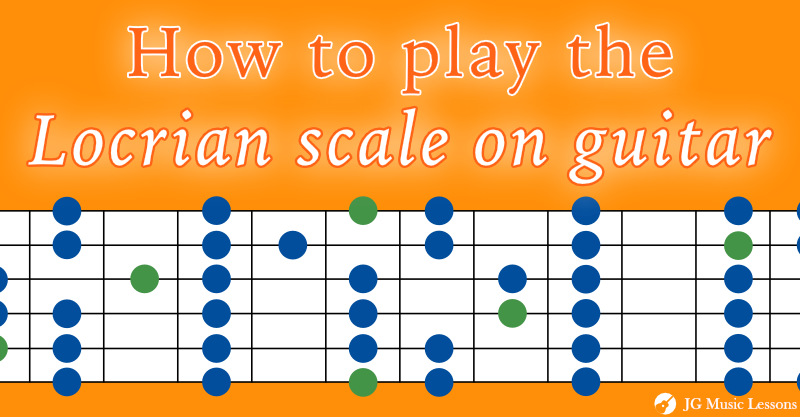The locrian scale is the 7th mode of the Major scale and is one of the least common and often misunderstood scales in music because of its dark and tense sound. If you’ve ever wondered what to play over minor 7 b5 chords (a.k.a. half diminished chords), you need to unlock this scale in your playing!
In this lesson, we’ll cover the music theory for the locrian scale, examples in different keys, learn the 5 locrian scale shapes on the guitar, and application examples! Grab your guitar and let’s get started!
Locrian scale formula
If you start and end on the 7th degree of the Major scale, you are playing a locrian scale. For example, the G locrian scale would have the notes G, Ab, Bb, C, Db, Eb, and F. These are the same notes as an Ab Major scale. In terms of scale degrees, the notes are root, b2, b3, 4, b5, b6, and b7.
If you notice, there is only one note difference between the locrian and phrygian scale. The locrian scale has a flat 2 scale degree, while the phryigan scale has a natural 2 scale degree. For example:
- C locrian scale: C, Db, Eb, F, Gb, Ab, Bb.
- C phrygian scale: C, D, Eb, F, Gb, Ab, Bb.
We can also look at the locrian scale formula in terms of whole and half steps. The formula would be half, whole, whole, half, whole, whole, and whole step between the scale notes.

You can also simply think of the parent scale it comes from, which is one half step above. For example, B locrian would have the same notes as a C Major scale. Or A locrian would have the same notes as a Bb Major scale.
Locrian scale examples with tabs
Here are some different dorian scales in music notation with guitar tabs below. The numbers above the notes on the top staff indicated which fingers to use on your fretting hand. If needed, check out how to read guitar notation symbols.
The following examples show you one way to play different scales in one octave but we’ll also cover how to play beyond one octave later in this lesson.
C locrian scale example

D locrian scale example

E locrian scale example

F locrian scale example

G locrian scale example

A locrian scale example

B locrian scale example

Locrian scale chart
The following chart includes the notes for all locrian scales.
| Locrian scale | 1 | b2 | b3 | 4 | 5 | b6 | b7 |
|---|---|---|---|---|---|---|---|
| C locrian scale | C | Db | Eb | F | G | Ab | Bb |
| D locrian scale | D | Eb | F | G | A | Bb | C |
| E locrian scale | E | F | G | A | B | C | D |
| F locrian scale | F | Gb | Ab | Bb | C | Db | Eb |
| G locrian scale | G | Ab | Bb | C | D | Eb | F |
| A locrian scale | A | Bb | C | D | E | F | G |
| B locrian scale | B | C | D | E | F# | G | A |
| Db locrian scale | Db | D | E | Gb | Ab | A | B |
| Eb locrian scale | Eb | E | Gb | Ab | Bb | B | Db |
| Gb locrian scale | Gb | G | A | B | Db | D | E |
| Ab locrian scale | Ab | A | B | Db | Eb | E | Gb |
| Bb locrian scale | Bb | B | Db | Eb | F | Gb | Ab |
Locrian scale shapes on the fretboard
The following section shows you the 5 locrian scale shapes throughout the guitar fretboard.
How to read the scale charts
For the charts below:
- The lowest horizontal line represents the thickest string (Low E). The top horizontal line represents the thinnest string (high E).
- The green circles represent the root note of the dorian scale and the blue notes are every scale note in between.
- The numbers inside the circles represent the suggested fingering to use on your fretting hand.
If needed, check out how to read guitar notation symbols.
Locrian scale shape 1
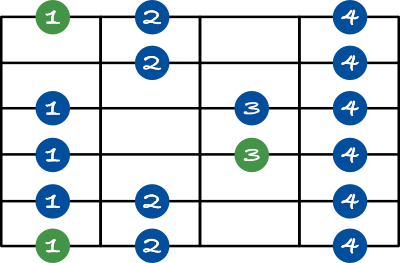
Locrian scale shape 2
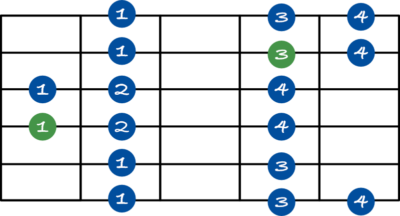
Locrian scale shape 3
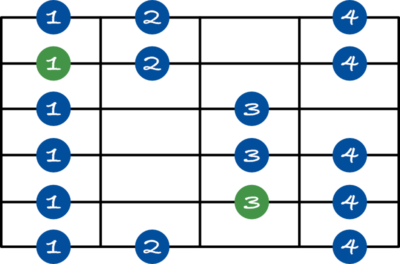
Locrian scale shape 4
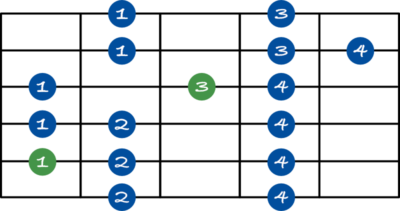
Locrian scale shape 5
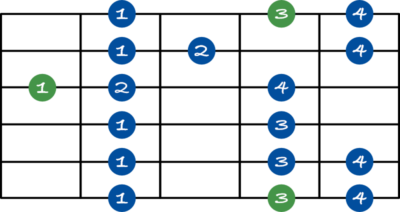
Connecting scale shapes on the fretboard
To put it all together, this is what the connected shapes look like throughout the fretboard for the B locrian scale below.

Locrian scale application examples
The locrian scale is ideal for playing over minor 7 b5 chords, also known as half diminished chords. Here are 5 application examples over different half diminished chords. If you’re not sure how to play these chords, see the essential 7th chords on guitar.
1. G locrian scale application
For the first example, we’re using the G locrian scale over the G half diminished chord.

2. C locrian scale application
Now, here is a C locrian scale example over a C half diminished chord.

3. B locrian scale application
For this application example, we are using a locrian scale pattern using an interval of thirds. The pattern starts and ends on the root of the B half diminished chord.

4. A locrian scale application (2 – 5 – 1)
The “2 – 5 – 1” is a common chord progression and in minor keys, the 2 chord takes a half diminished chord function.
Here is an example of a 2 – 5 – 1 in the key of G minor which has the chords A minor 7 b5, D 7 b9, and G minor 7.

5. F locrian scale application (2 – 5 – 1)
Here is another 2 – 5 – 1 example in the key of Eb minor where we use the F locrian scale over the F half diminished chord.

Wrapping up
If you want to dive deeper into improvisation, you want to get comfortable playing the locrian scale. Instead of getting confused about what to play over half diminished chords, you can confidently use this scale knowing that it will complement your improvisation.
You want to be able to memorize all the shapes well and then work on how to make the scale sound musical. For some ideas on how to do this, check out this guide on how to practice scales on guitar. You may also want to learn how make your melody lines sound jazzy.
You can also see an overview of the Major scale modes and their related emotions here or learn the specific scales below:
- Ionian scale (Major scale)
- Dorian scale
- Phrygian scale
- Lydian scale
- Mixolydian scale
- Aeolian scale (minor scale)
📘 Get the free guitar practice guide here!
Best,
JG Music Lessons
📙 Kickstart your guitar playing with our step by step guide: Guitar Essentials.
🎸 Looking for a travel or half-sized guitar? See this one.
🛠 See our other music recommendations.
🤝 Support the site to help us to create better content for you!
Level up with the FREE guitar practice guide and effectively improve your playing! 🎸
Get it sent to your email!

